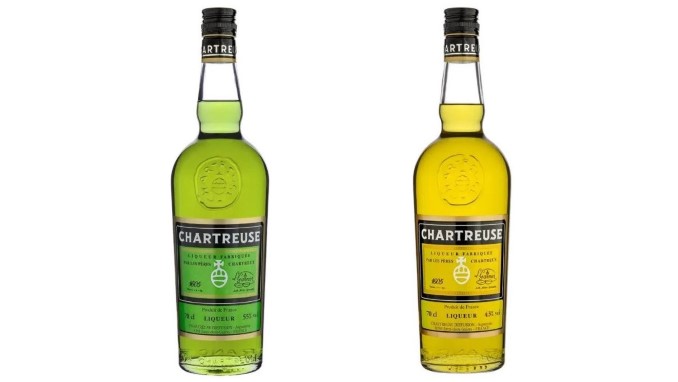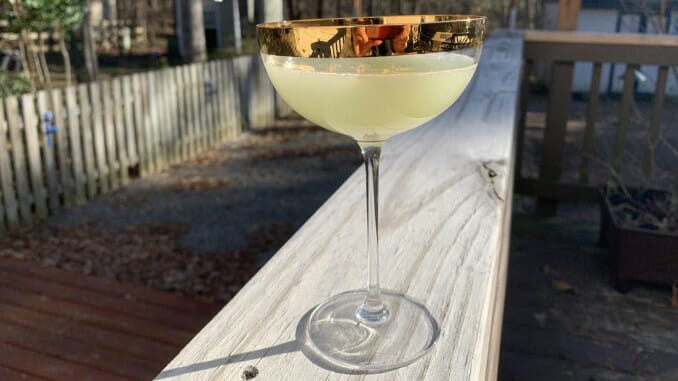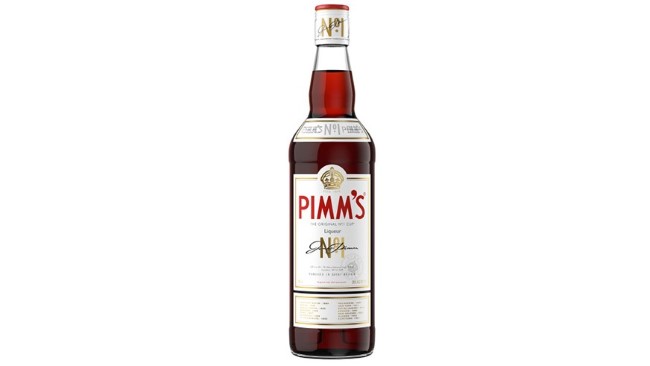The Green Chartreuse Shortage Is Real, and People Are Finally Noticing
Photo via Jim Vorel Drink Features cocktails
Edit: Since this piece was first published in 2022, the Carthusian Monks who produce Chartreuse in France have announced that production of the liqueurs was quietly capped at a set level in 2021. Thus, it hasn’t been a decrease in production that has caused shortages from 2021 onward, but rather the monks’ decision to not up their production levels to keep up with cocktail demand, focused as they instead are on their religious duties. For drinkers, this means the flow of Chartreuse from France will continue, but it will likely continue to be in short supply as long as its popularity in the cocktail scene remains at similar levels. Thankfully, a wide range of independent Chartreuse alternatives are increasingly becoming available in the U.S.
A few months ago, I received a rather worrying text from my aunt—the only aunt in the family who could conceivably send a text that would qualify as “worrying” from a cocktail geek’s standpoint. In it, she asked if I had seen any bottles of Green Chartreuse on liquor store shelves recently. I confessed I hadn’t really been looking—I have a full bottle of Chartreuse at home, and those who are familiar with the bittersweet herbal aperitif will understand that a full bottle of the potent elixir tends to last for quite a while unless you’re running a cocktail bar out of your home. But as she went on to say, she couldn’t seem to find a bottle of Chartreuse anywhere in her home state of Florida, no matter where she looked. The popular cocktail component had simply run dry everywhere she turned, leaving her unable to complete one of the four necessary ingredients for her favored Last Word cocktail. And if an entire state had potentially run out of Chartreuse, it got me wondering how widespread this issue might be.
Suffice to say, after digging into the online conversation surrounding these bottles more deeply, it’s become clear that there are a lot of places in the U.S. currently experiencing shortages or a total lack of Yellow and Green Chartreuse, not to mention similar shortages of other essential bartending liqueurs and liquors. The problems are fairly widespread, but haven’t been covered by the media (or even spirits writers) particularly extensively, outside of general pieces on “there are supply chain shortages right now” that have circulated throughout the entirety of the COVID-19 pandemic. I suspect that this is due to the inconsistent nature of the shortages, which have rendered bottles such as Chartreuse practically extinct in some markets, but plentiful in others.
Where I live, in Virginia, for instance, finding Chartreuse at the state-run ABC liquor stores is no problem at all. There are a few potential reasons for this—the state-wide ordering might result in a more even distribution of bottles at ABC stores across the state, while the significantly higher price point could also theoretically drive down demand state-wide, compared to Chartreuse consumption in other states. Point is, I can jump in my car right now and find a bottle of Chartreuse within 10 minutes or so. But for drinkers in other states, it’s become damn near impossible, and it seems like more drinkers are finally starting to take notice.
What Is Chartreuse, and Why Is It Scarce?
Both Yellow and Green Chartreuse (there are other varieties in Europe as well) are strong, herbal liqueurs produced by distillation by Carthusian Monks, with France as the center of production. Like many European liqueurs and amaro of this sort, Chartreuse has been around for ages—it’s been produced by the monks of the Grande Chartreuse monastery near Grenoble since 1737, reportedly from a recipe first developed in 1605. It is produced via distillation in copper pot stills, and maceration with an extremely complex blend of botanicals (citrus, thyme, saffron and more), herbs, fruit and spices before oak aging—Green Chartreuse reportedly is made with more than 130 botanicals. Both Yellow and Green Chartreuse have complex flavor profiles that are both sweet and bitter—the Yellow is somewhat milder and sweeter at 40% ABV (80 proof), while the Green is a sturdy 55% ABV (110 proof) and has a more bitter and resinous edge to it.
Chartreuse is popular as an aperitif, with the herbal components thought to stimulate the appetite and provide nebulous health benefits, but the bottles have truly come into their own in the U.S. market in the last few decades as cocktail components in the modern craft cocktail world. Green Chartreuse in particular has become a necessity in modern bartending, appearing in many recipes to offer a bittersweet, herbal component, but it’s particularly indispensable as part of the very popular Last Word, an equal parts blend of gin, lime juice, maraschino liqueur, and Chartreuse. The Last Word has become one of the country’s most popular Prohibition era cocktails since its rediscovery in 2004, and Chartreuse is a necessity in making it accurately. Hence, my aunt’s consternation when it disappeared from store shelves.

So, where did all the Chartreuse go, and when did the problems first begin? Well, it’s not a phenomenon that simply cropped up overnight. Some writers have been noting the shortages of Chartreuse and other liqueurs/bar staples since at least 2021, with many bartenders noting that they were being forced to modify their cocktail menus or find replacements for unobtainable ingredients such as Chartreuse. Only in more recent months, though, has it really seemed like consumers were catching on and starting to feel the pinch themselves. Perhaps these drinkers assumed that years into the pandemic and its various supply chain hurdles, we would have at least returned to “normalcy” as consumers and imbibers at this point. But if anything, the shortages seem more pronounced now than ever.
In 2022, it’s safe to say that the shortages of brands like Chartreuse are finally getting noticed by drinkers more widely. In the last few months, you can find multiple Reddit threads, or cocktail forum threads, of cocktail fans searching for that elusive bottle of Chartreuse since their last one ran dry. Entire major markets and states seem to have no access to bottles, or the bottles are immediately snapped up by desperate bar owners as soon as they arrive. National retailers, likewise, have no Chartreuse to sell — Total Wine notes that “This item cannot be added to cart, as we just ran out of stock.” K&L Wine Merchants, meanwhile, apparently has some in stock, but you can see it’s a recent development from the “back in stock!” sticker … and the strict limit per customer of how much you can purchase. You have to wonder how long that supply might last, especially when (last?) word gets out.
Edit: Well, that didn’t take long. In the time since this article went live, the listing for Chartreuse on K&L’s site has disappeared.
Nor is Chartreuse the only product of this nature that has become difficult to find recently. Pimm’s No. 1, a gin-based British liqueur essential for the iconic Pimm’s Cup, has disappeared from shelves in many markets as well. Paste editor Josh Jackson reports it doesn’t seem to be available in Atlanta, and the Pimm’s Cup has likewise become an endangered species in New Orleans, where it had built a rabid fanbase. In NOLA, bars entirely themed around the Pimm’s Cup face an existential crisis without access to it.

What, then, might these shortages share in common, and how does the pandemic play into such shortages even two years after the initial outbreak of COVID-19? The truth, it seems, is that these issues are extremely complex, and not easily blamed on one or two factors. Rather, there are many interconnected challenges that work together to restrict the availability of products such as Chartreuse, even more so than other products on the shelf.
For one, the rising price of fuel raises the costs of transportation, affecting every aspect of the supply chain—it becomes less profitable for European producers to ship their products overseas when those shipments suddenly cost much more. This is likewise assuming the producers are able to get their product packaged at all—a shortage of glass means that there are fewer bottles available to source, which disproportionately affects distilleries reliant upon glass bottles. Meanwhile, if the bottles get to the U.S. they can often be left sitting in warehouses due to the country’s ongoing labor shortage, resulting in fewer truck drivers/distribution workers than necessary. At every stage of the process, there are potential pitfalls to slow it down.
This is to say nothing of actually producing Chartreuse, a process we don’t know much about thanks to its monastic origins. But ask yourself: Would you want to be in charge of the production of an extremely complex distilled liquor, one necessitating 130 different botanicals, during the height of a global supply chain crisis? Can you still make Chartreuse if you’re missing a dozen ingredients? What kind of contingencies do these monks have in place for shortages that threaten production? These are the kinds of questions where I wish I had answers to report.
At the end of the day, it’s hard to say when nationwide access to bottles of imported spirits, such as Chartreuse, will rebound to pre-pandemic “normal” levels. There are simply too many mitigating factors to be able to make any kind of guess, and although that’s inconvenient for home consumers, it’s arguably a bigger and scarier proposition for bar owners and bartenders whose very livelihoods depends upon access to cocktail ingredients. Personally, I expect my bottle of Chartreuse will probably last as long as I need it to, but others won’t be nearly so lucky. Here’s hoping that lovers of the Last Word can lay hands on a bottle of Chartreuse soon.
Jim Vorel is a Paste staff writer and resident beer and liquor geek. You can follow him on Twitter for more drink writing.